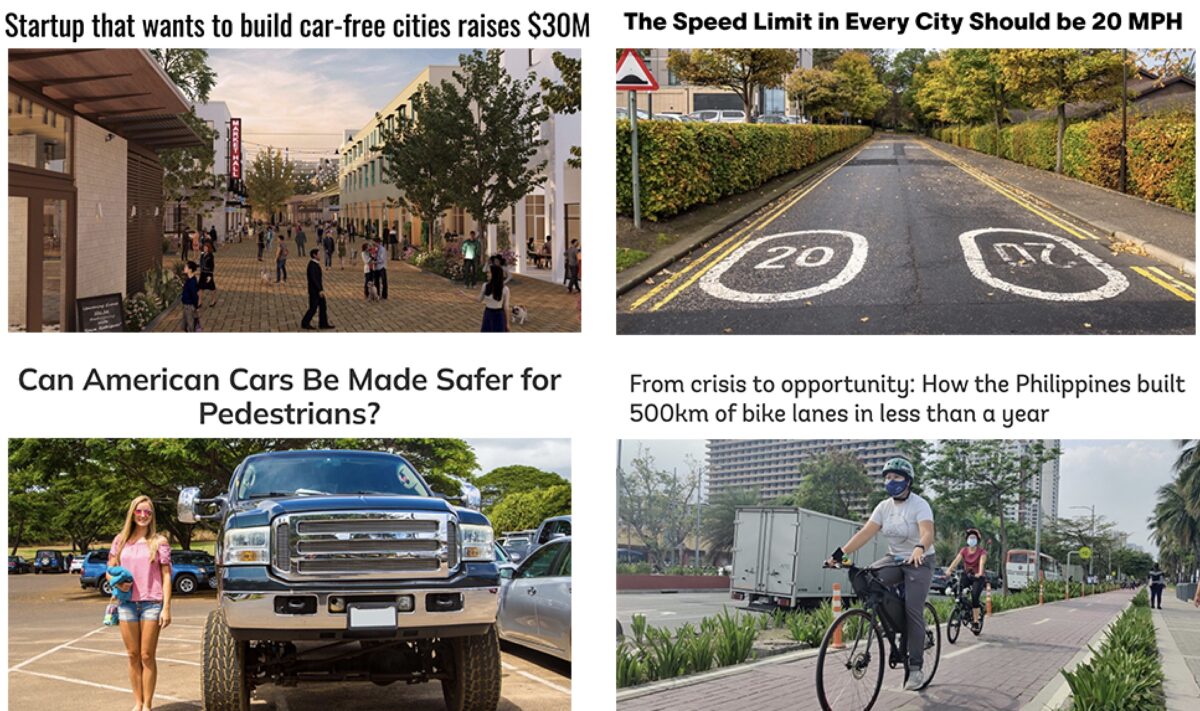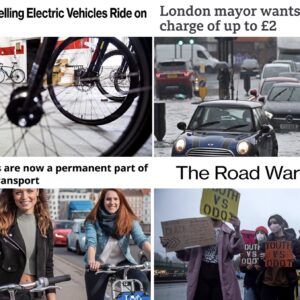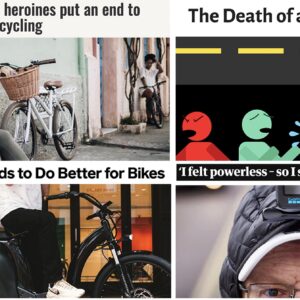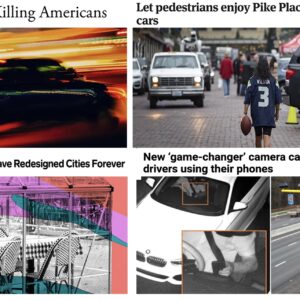Welcome to the week.
Here are the most notable stories our writers and readers came across in the past seven days:
Carfree capital: A startup named Culdesac has raised $30 million in venture capital (on top of $200 million already raised) to build a carfree city “from scratch” in Arizona.
This time, the Philippines: With each new country we hear about that seized the pandemic to make dramatic investments in cycling infrastructure — like the 310 miles and $22 million investment in the past year in the Philippines — it becomes even more clear that we should have done the same.
Seattle’s traffic death crisis: Our neighbors to the north are going through the same thing we are and KUOW has a solid breakdown of what’s going on. I think the UW prof who blames it partly on, “a very strong car culture, and an anti-pedestrian culture, that’s taken root all over the country,” is onto something.
Many cities faces this crisis: Los Angeles is also grappling with record traffic deaths. It’s almost as if the problem is not that “vision zero is failing” (a lazy and annoying framing many reporters take) but that drivers are totally out of control and we need even more robust engineering and enforcement countermeasures to restore order.
Advertisement
From the factory: Big news this week in the bike industry as Specialized announced it will sell bikes direct to customers via their website.
Sec. Pete on the NRSS: The US DOT’s exciting new National Roadway Safety Strategy was launched last week and Slate reporter David Zipper has an interview with the man who’s in charge of it.
The US DOT is cool now: One of the most important takeaways from the NRSS launch last week is that many national advocacy groups and transportation reform activists actually think it’s pretty darn good. Even noted advocacy journalist Alissa Walker gave it a “B” grade.
The big truck problem: It gives me a lot of hope for car/truck design reform when I see the issue being covered by outlets like Governing. It’s crucial to right-size vehicles if we want to get a handle on road deaths and injuries, and in just a few years this issue has gone from fringes to the mainstream.
The power of 20: Aaron Gordon has a great piece in Vice that goes beyond the “20 is plenty” mantra and talks about how 20 mph is a magic number when it comes to urban travel in general — regardless of mode.
Thanks to everyone who sent us links this week!







Thanks for reading.
BikePortland has served this community with independent community journalism since 2005. We rely on subscriptions from readers like you to survive. Your financial support is vital in keeping this valuable resource alive and well.
Please subscribe today to strengthen and expand our work.
Vision zero never had the opportunity to fail because not a single USAnian city/region ever made a serious committment to fund it. The $450,000 in safety improvements ($7230 per Portland traffic homicide) that Portland commissioners paint as some sort of political victory is an example of this lack of committment.
And also, VZ is supposed to be about preventing the worst outcomes despite driver behavior. Blaming its failure on drivers is non-sensical.
It’s fascinating how much resistance there is to the idea that it’s not driver behavior that causes the vast majority of fatal/serious-injury crashes but road/infrastructure/cage design. Many transportation safety advocates imagine they are “fighting a war against cars*” but much of their actual rhetoric focused on a pyrrhic and foolish “war on drivers”.
Good luck with that strategy, bourgeoisie urbanists.
*The “war on cars” was won by Fordists which is why most people now drive trucks (of the SUV or pickup variety).
It is driver behavior that’s the ultimate problem — if everyone followed the rules, we’d have far fewer crashes. But our facilities (and vehicles) need to be designed to accommodate the reality that humans will imperfectly adhere to the law, and far fewer people should die as a result.
I sometimes wonder, here I am in my 50s, I had driver’s training in another state 30+ years ago. Did take a test when I came to Oregon.
Why wouldn’t people have to show that one still has proficiancy in driving and at least at a minimum knows the rules of the road every 5 or 10 years? Maybe it’d be a part of the driver’s license renewal process. Answer 10 – 20 questions correctly and get your license, else come back another time and try again.
Seems like that might help a tiny bit and could just be part of general more informed driver population education campaign.
I retook my driving test from first principles a few years ago, and the knowledge test was ridiculously easy. The only “difficult” questions were about arbitrary limits that no driver ever thinks about, like how close can you follow a fire truck? 50ft or 100ft? Who knows? What does 100ft even look like from a car? How fast am I going? What’s going on around us?
I would not feel any more secure knowing drivers had recently passed the test. They’ll all pass, unless they show up high, and probably even then.
The ironic thing is that many, if not, most USAnian “rules” have little to do with safety (or basic respect for other human beings) and a lot to do with protecting the right of SUV/truck users to behave in an antisocial manner. This deregulation of social negative externalities is the epitome of social infrastructure neglect.
PS: Strict liability, strict licensing, mandatory education, and alternatives to the bloody truck are a form of infrastructure and one that is lacking in this dysfunctional society.
Did we do the same?
If we built just 6 miles of bike facilities per state, we’d have our 300 miles. If we spent just $400k pretty state doing so, we’d have or $20M. I’d be surprised if the US didn’t well exceed those thresholds during the last year.
This is not an argument that we built enough, but sometimes, like on the backstreets of Portland, less is more.
What we really need are deterrents for people like the guy I saw yesterday doing 40 along one of those backstreets, not even slowing for the stop signs he was blowing through.
Give me the traffic environment we had just 3 years ago, along with safe access to our existing bike paths, and I’d settle for zero new bike infrastructure for a few years.
Do you really think it makes sense to compare bike facilities on a per-country basis? Wouldn’t per-capita or per-land-area make a hell of a lot more sense?
Not at all. Nor does it make sense to compare transportation systems between vastly differently situated countries (economically, geographically, politically, culturally, etc.). It’s worth looking at what we can learn from other places, but the US is just different than the Philippines, so direct comparisons are probably not useful in much of any way.
Yeah you make a good point about extrapolating the mileage and funding statewide. We have build some stuff in the past two years and have spent some money. My point is that it hasn’t really shifted the needle in a way that it could have in our urban areas. We could have grabbed a bunch of space and put up a bunch more “temporary” stuff that would not be more or less permanent. The n’hood greenway “safe streets” stuff is a good example. We did something on those (only after looots of public pressure mind you), and they worked and now we’re making them more permanent. We should have done the same thing on larger streets with protected bike lanes. They would have been very successful and they’d now be more permanent. We can and should still do it! Just go take the space!
I question whether there is anything we can do to “shift the needle” at all. We keep building and improving facilities here in Portland, and ridership has fallen. It is clear to me that there is no causal connection between bike lanes and ridership, or if there is, the effect is swamped by other factors.
I love riding bikes, and want others to experience the joy and practical benefits they bring me, but I also know that I am an outlier in many ways, and I have come to realize that even a 10% mode share is probably unattainable in Portland (and less so elsewhere), though I would love to be proven wrong.
Nothing I wrote above should be taken as an indication that I disagree with this statement, so long as we have community buy-in.
That’s because its not intended to shift the needle. The infrastructure that is being installed is performative. PBOT wants people in their cars and it shows through every action that they take. That’s why most of our ‘bike infrastructure’ is paint, a little bit of it is some paint with cheap plastic wands, and maybe 5% of it is disconnected evidence-based infrastructure that form little pockets of safety in a sea of danger.
It’s a great example. PBOT had the opportunity where tons of people were using greenways who had never used them before, they had put up the dumb little beg barrels and they had the opportunity to turn them into actual diverters that actually protect people and they didn’t. There was no reason. They just chose to not put in traffic diverters.
At the end of the day, PBOT cares more about motorists ability to speed down greenways than they do bikes/peds ability to be safe on them. How could they possibly shift the needle when they absolutely refuse to take easy wins?
The biggest think Bike Loud and other groups could do is mark PBOT as the enemy of safety they are.
As down as I am on PBOT, your statement is simply false. If PBOT could get more people onto bikes or transit or walking, I am 100% sure they would do so. They just don’t know how (and may not be able to within the parameters of things they can legally do in a democratic society where the election system still works).
It’s no mystery why they half-ass things: cost. Not some sinister plan to keep people in their cars or some war on safety.
It’s not false at all. I’m sure there are plenty of people at PBOT who would like it if more people biked, walked, or took transit, but the leadership prefers cars which is why all PBOT designs ultimately are for motorists. Even our big ‘bike projects’ are designed for cars, like the N Greeley project.
If PBOT truly doesn’t know how to get people out their cars, thats just a sign that its time to clean house and get rid of the entire management team because there are tons of evidence-based design guides they could utilize and tons of cities around the country that are building high quality infrastructure they could look to.
Of course, PBOT spurns evidence-based design frequently for their fun little “experiments” that they do.
Complete and utter nonsense. Just look at our Greenways. PBOT always intended for motorists to be able to use them as through streets. Traffic diverters aren’t expensive, and now, we are literally spending the money for traffic diverters and getting useless concrete barrels that beg motorists to use a different street or drive 15 mph, neither of which they will do.
Money isn’t the reason PBOT wants to maintain through motorist access on “greenways”. If PBOT had installed even half the needed traffic diverters on greenways when they built them, we’d have one of the best bike grids in the country. But they didn’t so we don’t.
This is 100% true! Vancovuer BC has a network of diverters and signals at arterials for their greenways, and they are totally effective, widely used by people on bikes, and not used as routes by people driving. Using these routes does even resemble using Portland’s greenways. These barrels are a sad waste of money, and should be portrayed as monuments to the enduring service of the supremacy car culture!
Most PBOT staff would like OTHER PEOPLE to use inconvenient transit, bike on deadly-by-design arterials, or live in tiny traffic-sewer-adjacent apartments.
The land area of all of the islands is similar to that of Oregon. It’s much smaller than the USA.
Also, purchasing power of $20 million is much higher there: average low-skilled workers are paid 537 pesos a day, which is $10.5 a day, about 1/10th that of the USA. I believe the difference between wages of construction workers is even greater, so $20 million there is about $200 million in infrastructure funding here. Imagine if Oregon spent $200 million to build 300 miles of bike facilities in one year! Or if even the whole west coast (similar population) spent that much?
Regarding the article “The Speed Limit in Every City Should be 20 MPH”
I think this is the crucial part:
Sorry, but I have to LOL at this. Feel good measures don’t work. Enforcement does.
My oh so nice neighbors feel very good going 35+ in our 20 mph zones on the streets around me.
Do some speed enforcement every once-in-awhile and people would likely feel good about going the speed limit to NOT get a ticket.
Seems to me you missed the point stephan highlighted: just changing the speed limit doesn’t make people uncomfortable going more than 20; that requires other changes. IMO, enforcement can be one of those changes.
How does our traffic death rates compare to Seattle? I know we have been outpacing many other communities in this tragic statistic. It seems many in Portland try to downplay (like an ostrich putting their head in the sand) many of the problems here (homeless crisis, murders, shootings, traffic deaths, car thefts, etc). I’m so done with the “It’s everywhere!” excuse.
https://www.oregonlive.com/commuting/2021/09/traffic-deaths-up-for-beginning-of-2021-with-portland-outpacing-national-numbers.html
Regarding the traffic deaths: Megan McArdle has a theory that, when most of the economy shut down, and people were advised to stay at home, the proportion of “risky” or “anti-social” drivers shot up, compared to “safe” or “conscientious” drivers. Risk-seeking people may have thought “Who me? Stay home? Covid? IDGAF.” Many conscientious people were holed up, trying to limit the risk that they posed to other. Risky drivers then took advantage of empty, highway-style streets, and the behavioral norms shifted.
Those norms have yet to shift back. Pandemic stress and literal social distancing have contributed to dangerous behavior. As the pandemic has taken so much for so long, a lot of people feel like they’ve gotten a raw deal and act selfishly. So it might take some time to return to normal.
Traffic enforcement would be helpful, but. . . nowadays that’s apparently too complicated to pull off.
Too complicated and in a bizarre concept popular in Portland, enforcement is somehow considered racist and therefore we let people speed and injure and kill others. I don’t get it.
There’s a guy on Twitch, “TechTourist”, who livestreams as he rides his ebike around Manila. You can see the infrastructure the article talks about, but it’s still pretty hairy most places he goes.
Scary stuff!
Great to hear about the Philippine bike facility improvements. I’d heard from relatives how congested with motor vehicles Manila had become (it could take an hour to go a mile…) and how correspondingly bad the air quality was. My thinking years ago was that bicycles would be a great solution in such a high-density city, and that they should be looking at Copenhagen or Amsterdam for what a modern city can be, instead of following the American auto-oriented image of progress. Wonderful to hear this positive news from my mother’s home country. Interesting to hear that they received support from the Australian and Dutch governments, given the fact that the Philippines was a US territory for several decades.
I once was a “20 is Plenty” advocate…but sadly we need to lower the bar even lower: 15 mph for most residential streets since many are still without sidewalks now…and the level of due care by many drivers has slipped even lower than it once was and definitely since COVID. BUT to build support for this local jurisdictions will have to focus on schools zones (get back to school, I say) with a 15 mph speed limit (collector and local) and build political support to more expansive implimentation areas.